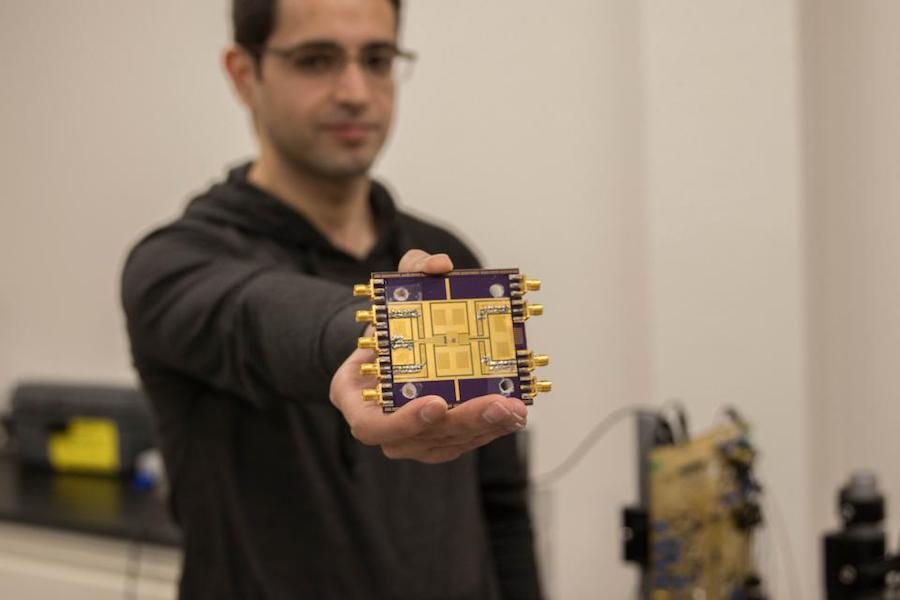
Researchers successfully create chip that may pave way for next generation technology
A high frequency electrical chip has been developed at UC Davis that surpasses the speeds of current technology. Graduate student Hossein Jalili came to UC Davis in 2013 to conduct research under Omeed Momeni, an assistant professor in electrical and computer engineering. They worked together to create a novel chip with a phased array antenna system.
“I’ve always been interested in mathematics and more attracted to those kinds of things rather than humanities,” Jalili said. “Engineering is an exciting field, especially electrical engineering and electronics today.”
Jalili’s work stems from Momeni’s previous Ph.D. work on terahertz integrated circuits. Their next step was to push the range of operation in these circuits higher.
“What is it that we can do to make wireless systems more effective and more usable for everybody?” Momeni said. “One of the solutions is you need to go to higher frequencies, because at lower frequencies, everything is so congested and the bandwidth is not there.”
Their current chip can reach 370 gigahertz (GHz) with 52 GHz of bandwidth, while cell phones or routers work around 800-900 megahertz (MHz) to 1-5 GHz with tens of MHz of bandwidth.
The growing problem with current systems, like 4G and LTE networks for cell phones, is that many users are on low frequencies at the same time, using up a limited amount of bandwidth. However, going to higher frequencies would open up more bandwidth for each user.
“Everybody knew to go to higher frequencies,” Momeni said. “The problem was that nobody could do it because the frequency was so high. When frequency gets high, it becomes challenging to do the design.”
Bandwidth is like a freeway: the more of it you have, the faster data can travel. Rouzbeh Kananizadeh, another one of Momeni’s graduate students, explained that most Wi-Fi frequencies are 2.4GHz, which is comparable to a road with 3 lanes. Raising that to 100GHz could be a freeway with 20 lanes.
“[Jalili’s chip] basically is a 50 lane freeway,” Kananizadeh said. “It’s high frequency, small, can be used in portable devices [for regular customers of terahertz devices], has high bandwidth, and the ‘eyes’ of the antenna can cover a large area, probably four times more than some existing circuits.”
Higher frequencies can allow for higher bandwidth, which means higher data rate. For example, a 1GB download of a movie can take anywhere from less than a second to half an hour depending on how much bandwidth is available or how “fast” it is.
“[The chip is] basically a signal generator that can change its frequency in a very wide range and, at the same time, radiate the signal into the air at a specific direction,” Momeni said. “If you look at your internet routers at home or your cell phones, they all have a signal generator inside and an antenna that radiates a signal. [Jalili and I] did the same thing, but at much higher frequencies than a cell phone or router would operate.”
A phased array antenna system consists of multiple smaller antennae sending out the same signal to direct a single narrow signal toward another object in a specific direction. One advantage of this system is its ability to shift its beam electronically, rather than mechanically, which creates potential for various applications. Higher power is achieved because the transmitted power can be funneled into a narrow beam and is less sensitive to interference. Beam-forming is one of the major concepts that will be incorporated into 5G, the next generation of cellular networks.
“If you want to get enough power and better performance, instead of having one source of power, you want to have an array of sources and have them all be coherent and synchronized,” Jalili said. “That was our goal to implement those kinds of array structures.”
Integrated circuit design for lower frequencies (radio frequency and microwave) has been studied extensively and is well-established in the engineering community, while integrated circuit design for higher frequencies (millimeter and terahertz) is an emerging field. Much of Jalili and Momeni’s work has been realized through trial and error in their designs and simulations.
Though higher frequencies can allow for faster data rates, there are a lot of limitations that have yet to be solved. Lower frequencies usually work better indoors, since they can pass through walls, while higher frequencies cannot.
“The bandwidth is available, but it’s hard to use it to actually get the advantages out of it because of the limitations on the circuitry,” Jalili said.
The research on this specific chip is still relatively new and will require additional testing, as well as advancement from other areas of electrical and computer engineering. However, Jalili and Momeni see their work improving various real-life applications, like spectroscopy imaging, radar imaging, safety and security detection, and the sensors of self-driving cars. Kananizadeh also stated that faster, simpler circuits can help the telecommunications industry go greener, since it takes money and energy to create and sustain systems like large server rooms.
“One of the excitements of my life is that you work so hard for a couple of years, and you come up with an idea that nobody has ever done before,” Momeni said. “It opens up the possibilities to do different things in the future for everybody.”
Written By: Jack Carrillo Concordia — science@theaggie.org




